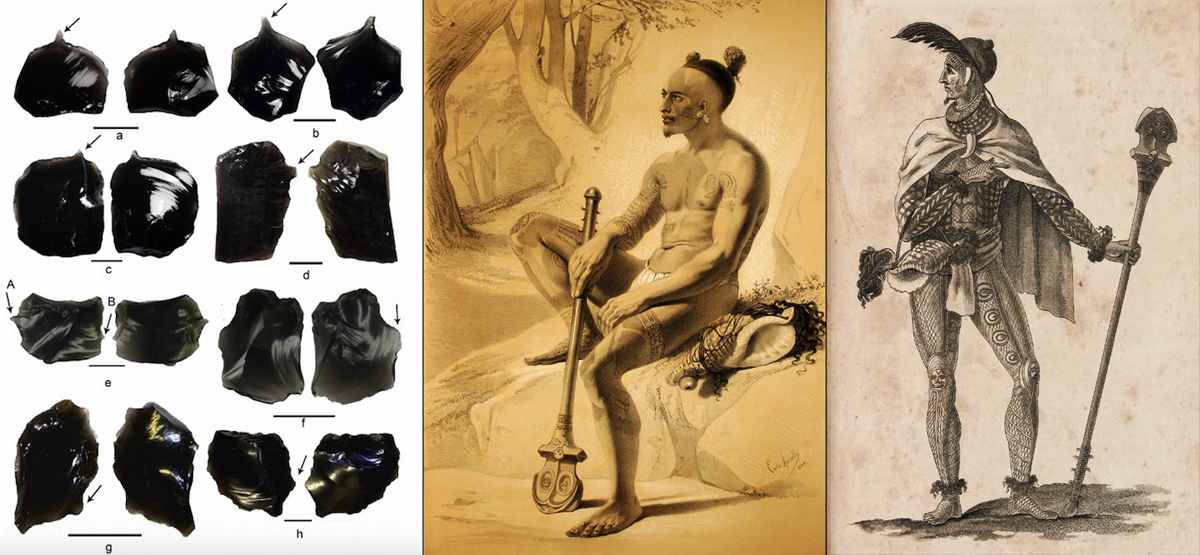


An article by Bob Yurka on phys.org - South Pacific Islanders may have used obsidian 3,000 years ago to make tattoos - reports new evidence of obsidian tools being crafted for use in creating tattoos approximately 3,000 years ago by South Pacific Islanders.

In their paper published in the Journal of Archaeological Science: Reports, Nina Kononenko and Robin Torrence with the University of Sydney and Peter Sheppard with the University of Auckland, describe experiments they conducted using cut obsidian to create tattoos on pig skin, to help explain how and why prehistoric people used a variety of techniques to create tattoos.
Anthropologists and archaeologists have always noted the lack of evidence of tattooing in ancient peoples due to skin degeneration. Even tools used may have been made of biodegradable material such as fish bone. In this new reserach, the scientists tested the possibility of using obsidian as a tattoo tool by ancient people living in the South Pacific.
Obsidian, the researchers suggest, would have been an obvious choice, due to its sharp, glass-like features. They focused their attention on the Solomon Islands as a possible site of early tattooing activities, with its long history of tattooing and easy access to obsidian (formed as lava from a volcano cools). Moreover, obsidian artefacts have been found at a site called Nanggu and dated back approximately 3,000 years.
To test the possibility that the artefacts had been used to create tattoos, the researchers gathered obsidian samples from island sites, fashioned them into roughly the same shapes as the artefacts, then used them to create tattoos on pigskin. Afterwards, they compared microscopic views of the artefacts and those tools they had created and used.
The sample tools looked remarkably similar under the microscope to the artefacts; similar signs of use, such as chipping, rounding and blunting as well as thin scratches. In addition, the artefacts had traces of ochre, charcoal and blood on them. Thus, the researchers suggest their experiments offer strong evidence of obsidian tools being used by early islanders to create tattoos.
Nina Kononenko et al,
Detecting early tattooing in the Pacific region through experimental usewear and residue analyses of obsidian tools
Journal of Archaeological Science: Reports (2016). DOI: 10.1016/j.jasrep.2016.05.041
Abstract
Although tattoos have been observed on mummies dated to over 5000 years old, the generally poor preservation of human remains makes it difficult to use this type of adornment to understand how inscriptions on the body have been used to define self and social ascriptions. A potential method for detecting tattooing is to identify the tools used to make the markings. To assist recognition of tattooing tools, an extensive set of experiments was conducted in which retouched obsidian flakes bearing various pigments were used to pierce pig skin. Diagnostic use wear and residues associated with tattooing were identified. To illustrate the value of these results, traces preserved on a highly recognizable class of obsidian retouched artefacts from the Nanggu site (SE-SZ-8) in the Solomon Islands were analysed. Results indicate that these tools were used to pierce skin and may therefore have been tattooing implements involved in social, ritual and/or medical practices.
by Bradshaw Foundation
Friday 14 July 2023
by Bradshaw Foundation
Monday 22 November 2021
by Bradshaw Foundation
Tuesday 12 July 2016
by Bradshaw Foundation
Thursday 23 June 2016
by Bradshaw Foundation
Tuesday 07 June 2016
by Bradshaw Foundation
Tuesday 29 March 2016
by Bradshaw Foundation
Wednesday 15 April 2015
by Bradshaw Foundation
Friday 27 March 2015
by Bradshaw Foundation
Wednesday 04 March 2015
by Bradshaw Foundation
Thursday 05 February 2015
by Bradshaw Foundation
Wednesday 04 February 2015
by Bradshaw Foundation
Thursday 26 June 2014
by Bradshaw Foundation
Friday 31 January 2014
by Bradshaw Foundation
Monday 20 January 2014
by Bradshaw Foundation
Friday 19 June 2009
by Bradshaw Foundation
Thursday 09 October 2008
by Bradshaw Foundation
Friday 14 July 2023
by Bradshaw Foundation
Monday 22 November 2021
by Bradshaw Foundation
Tuesday 12 July 2016
by Bradshaw Foundation
Thursday 23 June 2016
by Bradshaw Foundation
Tuesday 07 June 2016
by Bradshaw Foundation
Tuesday 29 March 2016
by Bradshaw Foundation
Wednesday 15 April 2015
by Bradshaw Foundation
Friday 27 March 2015
by Bradshaw Foundation
Wednesday 04 March 2015
by Bradshaw Foundation
Thursday 05 February 2015
by Bradshaw Foundation
Wednesday 04 February 2015
by Bradshaw Foundation
Thursday 26 June 2014
by Bradshaw Foundation
Friday 31 January 2014
by Bradshaw Foundation
Monday 20 January 2014
by Bradshaw Foundation
Friday 19 June 2009
by Bradshaw Foundation
Thursday 09 October 2008
Friend of the Foundation











